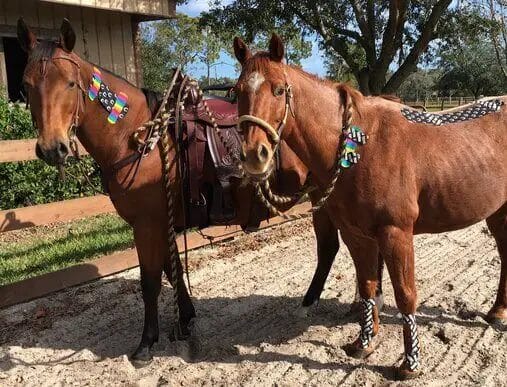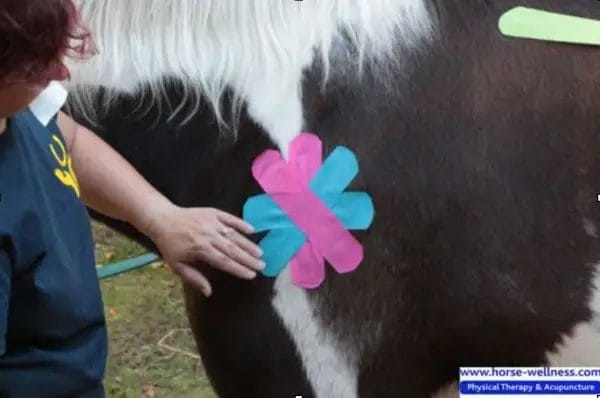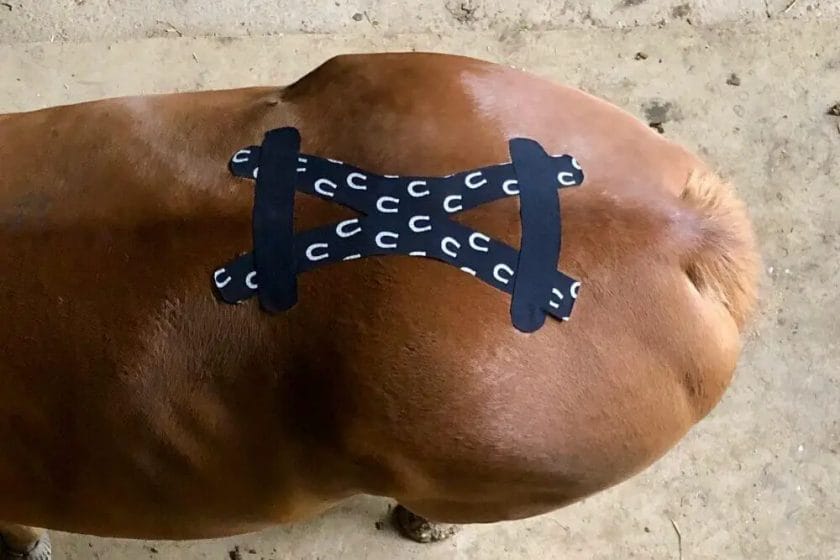If you’re wondering why people tape a horse, it’s because taping can be a useful technique in horse care and training. Taping is often done to support or protect a horse’s limbs or ears. In the case of limb support, taping can provide stability and reduce the risk of injury during exercise or rehabilitation. Eartaping, on the other hand, is commonly used to train show horses to hold their ears in a desirable position. By carefully applying tape, horse owners and trainers can achieve specific goals and enhance the horse’s overall well-being and performance.

Taping Techniques for Different Horse Injuries
When it comes to aiding in the recovery of common horse injuries, taping techniques can be highly effective. Proper taping can help support injured areas, reduce swelling, and provide stability during the healing process. In this section, we will discuss specific taping methods for different horse injuries that every horse owner and handler should know.
1. Taping for Sprained Joints
Sprained joints are a common type of injury among horses, especially in highly active or athletic animals. Taping can provide support to the affected joint, allowing for proper healing and preventing further damage. The following steps outline a taping technique for sprained joints:
- Start by cleaning the affected area and ensuring it is dry.
- Apply a pre-wrap or adhesive padding around the joint to protect the skin.
- Begin taping at the base of the limb, wrapping the tape around in a spiral motion towards the joint.
- Overlap the tape by about half its width with each wrap to provide adequate support.
- Continue wrapping until you reach the joint, making sure the tape is snug but not too tight.
- Secure the end of the tape with a clip or adhesive tape.
This taping technique helps stabilize the sprained joint and provides support during movement, aiding in the healing process.
2. Taping for Tendon Injuries
Tendon injuries are another common issue among horses, particularly in the legs. Taping can help reduce strain on the injured tendon and promote healing. Follow these steps to tape a tendon injury:
- Start by cleaning and drying the affected area.
- Apply a thin layer of adhesive padding over the injured tendon.
- Begin taping at the base of the limb, wrapping the tape in a figure-eight pattern around the injured area.
- Ensure that the tape is snug but not too tight, as excessive pressure can impede blood circulation.
- Continue wrapping until the injured area is adequately supported.
- Secure the end of the tape with a clip or adhesive tape.
This taping technique provides stability to the injured tendon, minimizing further damage and promoting a faster recovery.
3. Taping for Hoof Injuries
Hoof injuries are quite common in horses, and taping can be beneficial in protecting and supporting the affected hoof. Follow these steps to tape a hoof injury:
- Clean the injured hoof thoroughly and ensure it is dry.
- Apply a hoof wrap or adhesive padding to protect the hoof wall.
- Start taping at the bottom of the hoof, wrapping the tape in a diagonal pattern towards the coronet band.
- Overlap each wrap by about half its width to provide sufficient support.
- Continue wrapping until you reach the coronet band, ensuring the tape is snug but not overly tight.
- Secure the end of the tape with a clip or adhesive tape.
This taping technique helps stabilize the injured hoof, preventing further damage and promoting proper healing.
4. Taping for Muscle Strains
Muscle strains can occur in horses, particularly in areas such as the neck, back, or hindquarters. Taping can provide support and aid in the recovery of muscle strains. Follow these steps to tape a muscle strain:
- Clean the affected area and ensure it is dry.
- Apply a pre-wrap or adhesive padding over the strained muscle.
- Begin taping at the base of the muscle, wrapping the tape around in a spiral or crisscross pattern.
- Overlap each wrap by about half its width to provide adequate support.
- Continue wrapping until the strained muscle is adequately supported.
- Secure the end of the tape with a clip or adhesive tape.
This taping technique helps stabilize the strained muscle, allowing for proper healing and preventing further strain.
Summary
Taping techniques can be highly beneficial in aiding the recovery of common horse injuries. Whether it’s a sprained joint, tendon injury, hoof injury, or muscle strain, taping provides support and stability during the healing process. By

Taping for Hoof Support and Protection
When it comes to maintaining the health and performance of a horse, proper hoof care is of utmost importance. A horse’s hooves are vulnerable to various injuries and conditions, and providing additional support and protection can help promote their overall well-being. One technique that has gained popularity in recent years is taping, which involves applying specialized tapes to the hooves for enhanced support and protection. Let’s explore how taping can benefit your horse’s hooves.
1. Support for Weak or Damaged Hooves
Taping can be particularly beneficial for horses with weak or damaged hooves. Whether due to injury, disease, or genetic factors, some horses may have hooves that are prone to cracking, chipping, or becoming excessively worn. By applying tape to the affected areas, it can provide additional support and stability to the hoof, minimizing further damage and promoting the healing process.
Specialized tapes with adhesive properties are available in the market that adhere well to the hoof wall, creating a protective layer and reducing the pressure on the weak or damaged areas. This extra support can help prevent further deterioration of the hoof and allow the horse to move comfortably.
2. Protection from External Factors
Horses often encounter various environmental elements that can potentially harm their hooves. Wet and muddy conditions, abrasive surfaces, and exposure to chemicals or sharp objects can all pose risks to hoof health. Taping can serve as a protective barrier against these external factors.
By wrapping the hooves with a suitable tape, it creates a shield against moisture, dirt, and debris, preventing them from entering and causing damage. Additionally, certain tapes have properties that make them resistant to wear and tear, offering long-lasting protection to the hooves.
3. Support during Rehabilitation
Taping can also play a vital role in the rehabilitation process for horses recovering from injuries or undergoing hoof-related treatments. For example, in cases of hoof abscesses or laminitis, a customized taping technique known as “heel-first” taping can help distribute weight evenly and relieve pressure from the affected area.
Furthermore, during the recovery period, it’s crucial to provide the horse with proper support and protection. Taping can serve as an additional aid alongside other treatment methods prescribed by a veterinarian or farrier, helping to promote a faster and more successful recovery.
4. Performance Enhancement
Not only does taping provide support and protection, but it can also contribute to improved performance in horses. By applying tapes strategically, it can help enhance proprioception and stimulate blood circulation in the hooves.
Proprioception refers to the horse’s awareness of its body and limbs in relation to its environment. The use of certain tapes can provide sensory feedback, improving the horse’s balance and coordination during movement. This can be particularly beneficial for performance horses involved in activities such as jumping, dressage, or racing.
Additionally, the stimulation of blood circulation through taping can aid in hoof health by promoting the delivery of oxygen and nutrients to the tissues, facilitating growth and repair.
Taping can offer valuable support and protection to a horse’s hooves, especially in cases of weak or damaged hooves, as well as during rehabilitation and performance enhancement. It is important to consult with a knowledgeable equine professional, such as a veterinarian or farrier, to determine the appropriate taping technique and materials for your horse’s specific needs. By incorporating taping into your horse’s hoof care routine, you can help ensure their overall well-being and maintain their optimal performance.

Taping for Corrective Purposes
When it comes to addressing postural or movement issues in horses, taping can be a valuable tool in the hands of a skilled equine professional. By using specialized tapes, such as kinesiology tape or adhesive bandages, practitioners can provide support, stability, and corrective cues to help the horse improve its alignment and movement patterns.
One of the primary goals of taping for corrective purposes is to encourage the horse to adopt a more optimal posture or alignment. This can be especially beneficial for horses with poor conformation, asymmetry, or musculoskeletal imbalances. By applying the tape strategically, the practitioner can help the horse’s body to better understand and execute correct movement patterns.
There are several ways in which taping can assist in correcting postural or movement issues in horses:
1. Support and Stability
Taping can provide additional support and stability to targeted areas of the horse’s body. For example, if a horse has a weak or unstable joint, such as the fetlock or hock, taping can help to reinforce the joint and prevent excessive movement or strain. By providing this extra support, taping can help the horse maintain a more correct posture and movement pattern.
2. Corrective Cues
Taping can also be used as a visual and tactile cue for the horse to encourage correct movement patterns. By applying tape in a specific direction or pattern, the practitioner can guide the horse’s body into alignment and help it understand the desired movement. For example, if a horse tends to have a dropped or inverted back, taping can be used to encourage a more lifted and engaged posture.
3. Muscle Activation and Relaxation
Taping techniques can also be utilized to facilitate muscle activation or relaxation, depending on the specific needs of the horse. By applying the tape in certain areas, practitioners can provide gentle stimulation to activate weak or underused muscles. On the other hand, taping can also be used to relieve tension and promote relaxation in overactive or tight muscles. This can help the horse achieve a more balanced and efficient movement.
4. Postural Re-education
Taping can play a role in re-educating the horse’s postural habits, especially in cases where the horse has developed compensatory patterns due to pain or injury. By providing support and corrective cues through taping, the practitioner can help the horse relearn how to move correctly and comfortably. Over time, this can lead to improved posture, movement efficiency, and overall performance.
In summary, taping can be an effective tool for addressing postural or movement issues in horses. By providing support, stability, corrective cues, and muscle stimulation, taping can assist in correcting certain imbalances and promoting more optimal alignment and movement patterns. However, it’s important to note that taping should always be done under the guidance of a trained professional to ensure proper application and to avoid any potential adverse effects.
Taping as a Preventive Measure
When it comes to horse care and performance enhancement, taping has emerged as a valuable tool. This preventive measure involves using specific types of tapes to support the horse’s muscles, joints, and tendons, thereby reducing the risk of injuries and enhancing performance. In this section, we will explore how taping can be effectively utilized to proactively prevent injuries and aid in the overall well-being of horses.
The Importance of Preventive Measures
As horse owners and trainers, it is our responsibility to prioritize the health and well-being of our horses. Preventive measures play a crucial role in maintaining the physical fitness and performance of these magnificent animals. By utilizing techniques such as taping, we can significantly reduce the chances of injuries, allowing horses to perform at their best without compromising their long-term health.
The Benefits of Taping
Taping has gained popularity among horse owners and trainers due to its numerous benefits. Some of the key advantages of using tape as a preventive measure include:
- Injury Prevention: Taping provides additional support to the horse’s muscles, joints, and tendons, reducing the risk of strains, sprains, and other injuries during physical activity.
- Enhanced Performance: By offering stability and proprioceptive feedback, taping can improve the horse’s balance, coordination, and overall performance.
- Pain Relief: Certain taping techniques, such as kinesiology tape, have been found to alleviate pain and discomfort by promoting proper alignment and reducing inflammation.
- Quicker Recovery: In the unfortunate event of an injury, taping can aid in the horse’s recovery process by providing support to the affected area and promoting proper healing.
Types of Tapes Used in Equine Taping
Equine taping involves the use of various specialized tapes, each designed to serve a specific purpose. Some of the commonly used types of tapes in equine taping include:
| Tape Type | Function |
|---|---|
| Kinesiology Tape | Offers dynamic support, improves circulation, and helps with pain relief. |
| Elastic Adhesive Bandage (EAB) | Provides compression and support to joints and muscles. |
| Pre-Wrap Tape | Used as a protective layer under other tapes to prevent skin irritation. |
| Stretch Tape | Offers strong support and stability to injured or weak areas. |
Proper Application Techniques
For taping to be effective, it is essential to follow proper application techniques. Consulting with a professional equine therapist or veterinarian is highly recommended to ensure correct taping methods. However, here are some general guidelines to consider:
- Cleanse and dry the area before applying tape.
- Apply any necessary padding or pre-wrap to protect the skin.
- Stretch the tape to the desired tension, ensuring it is not too tight.
- Smooth the tape carefully to avoid wrinkles or creases.
- Monitor the horse’s response and adjust the taping if needed.
In Summary
By incorporating taping as a preventive measure, horse owners and trainers can actively contribute to the overall well-being and performance enhancement of their horses. Taping helps reduce the risk of injuries, improves performance, alleviates pain, and aids in the recovery process. Proper application techniques and the use of specialized tapes ensure the effectiveness of this preventive measure. Remember to consult with professionals for guidance and enjoy the benefits of taping as a proactive approach to horse care.
FAQs
Why would someone tape a horse?
Taping a horse is done for various reasons, such as providing support and stability to injured limbs, correcting posture or alignment issues, and promoting proper muscle development. It can also be used to encourage proper movement and prevent excessive strain during training or competition.
Conclusion:
In conclusion, tape is used on horses for various purposes and benefits. Whether it is for medical treatments, preventive measures, or training aids, taping a horse can provide valuable support and protection. By using specialized tapes, such as adhesive bandages or kinesiology tape, horse owners and trainers can aid in injury recovery, reduce swelling, and provide stability to joints and muscles. Additionally, taping can be used to modify the horse’s gait, correct posture, and improve performance. However, it is crucial to consult with a veterinarian or equine professional before applying any tape to ensure proper usage and avoid potential risks. By using tape judiciously and with expert guidance, horse owners can enhance their horse’s well-being and performance.
